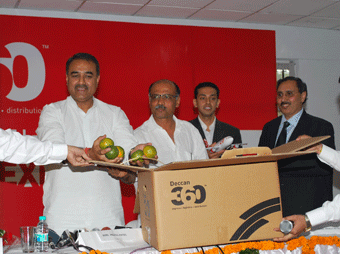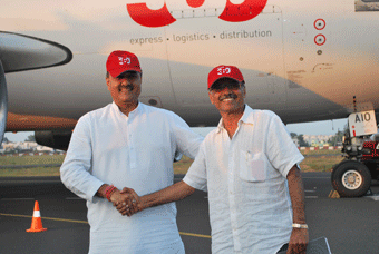Praful Patel and Capt. Gopi display
a consignment of fresh oranges from Nagpur during the announcement of
the launch of Deccan 360's operations from the Nagpur hub
Praful Patel and Capt. Gopi pose for a photo
in front of one of the eight Deccan 360 freighters sporting the company's
distinctive red caps.
November begins a new era for India express
logistics.
The first Indian company to create a hub
and spoke distribution model also launched operations November 9.
Capt. Gopinath and his Deccan 360 have
taken off with 8 freighters that now are covering and connecting 15
leading India gateway airports.
Deccan has a fleet of over 300 trucks
and 850 vehicles nationwide, 8 major surface hubs, with a capacity of
more than 300 tons per night by air and more than 60 warehousing hubs.
The master plan delivers overnight services
to 50 cities – achieved by more than 60 franchisees nationwide.
At the core of Deccan 360’s hub
and spoke model is the state-of-the-art hub being developed across a
total area of 50 acres at Nagpur.
Capt. Gopi has signed a MoU with the GMR
group, for setting up express cargo operating facilities at Delhi and
Hyderabad airports, which, together with the central hub in Nagpur will
form an extensive multimodal (surface and air) storage, transportation
and delivery network bringing connectivity to every corner of the country.
He has also set up a central call center
at Bangalore.
Speaking at the launch, which also was
attended by the country’s Civil Aviation Minister Praful Patel,
Deccan 360 Chairman and Managing Director Capt. Gopinath said that his
vision was that of an express cargo and logistics network which would
not only make markets and consumers come closer in the metros and in
the hinterlands but would also create opportunities for people in all
parts of the country.
Deccan 360, he said provides a network
leveraging, with which a small auto parts manufacturer in Jaipur would
be able to efficiently feed the supply line of Toyota near Chennai while
a mango farmer from remote Maharashtra can ship fresh alphonso mangoes
across the country.
Capt. Gopi is a strong advocate of the
yet-to-be-ready first hub of India at Nagpur but a recent study authored
by three researchers – Dr. Arpita Mukherjee from the Indian Council
for Research on International Economic Relations, Dr. Partha Pratim
Pal and Dr. Subrata Mitra from one of the top business schools in the
country, the Indian Institute of Management, Kolkata – points
out that though the city and its airport in the centre of India has
certain advantages, it would not be able to serve its purpose.
The study says, “at the onset it
looks like Nagpur has been the right choice. However, some recent reports
have criticized the choice of the airport as a hub.”
The researchers did a nationwide survey
of 133 express companies, 90 clients and 25 freight forwarders to understand
the feasibility of Nagpur as a hub for express delivery services and
found that the industry preferred operating on a “hub and spoke”
model.
Their survey found out that the volume
of traffic was the most important determinant for the location of a
hub. Citing the case of UPS shifting its hub from Philippines to China
with the increase in the volume of traffic, the professors claimed that
the hub in Nagpur would not receive the volumes.
The survey also found out that most express
delivery companies did not have a major interest in setting up a hub
at Nagpur.
This was evident from the fact that while
the Express Delivery Council of India had a common user terminal in
Delhi and Mumbai, it had not taken up space in Nagpur since its member
companies have not expressed any interest. Companies like Fedex and
DHL, which have developed gateways in airports like Delhi, have also
shown no interest in Nagpur.
Major express companies even pointed out
that though Nagpur was centrally located, express freight movement was
currently between west-south, west-north and south-north in the country.
The western part of India, mainly Mumbai, received the maximum volume
of goods followed by the northern and southern parts of the country.
Additionally, a very high percentage of the cargo flew in either from
the U.S., Europe or Gulf countries to India.
In such a scenario, flying the consignments
to Nagpur and then sending them back to Mumbai would not make sense.
Also, the flying time and the necessary
fuel cost to Nagpur were more than to Delhi or Mumbai if the cargo was
from western countries.
Tirthankar Ghosh |





